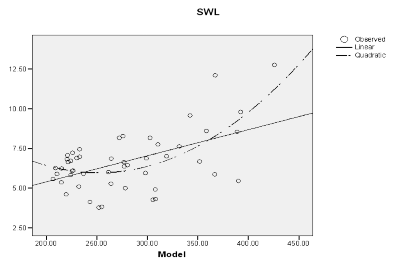Analysis of Mutual Interaction Effect of Six-Individual Characteristic Factors of Safe Weight Lift Model
DOI:
https://doi.org/10.47355/jaset.v3i2.53Keywords:
Low back pain; Male; Mutual interaction effect; Safe Weight Lift; Strain energyAbstract
An ergonomic mathematical model to compute Safe Weight Lift (SWL) was formed with principle of strain energy to limit risk of low back pain amid construction employees in Nigeria. However, mutual interaction effect of the selected factors were not yet studied. Therefore, analysis of mutual interaction effect of compounded chosen male distinctive factors of biomechanical of body weight, spinal shrinkage, and spine length, with physiological of age, and gender also, psychophysical of surrounding temperature and lift frequency were done. The factors data were gotten using ZT-160 scale, tailor-tape rule, fly-back timing and RH/Temperature pen from fifty masculine manual construction workers selected using purposive sampling technique. The data were inputted into Ms Excel and SPSS for analyses using Multiple Linear Regression (MLR), Regression Curve Estimate (RCE), and ANOVA at alpha level 0.05. The MLR investigation shown that mutual interactions of the compounded factors were significant (p=0.00) and gave R2=0.94, while RCE predicted quadratic relationship with the SWL (p=0.00), and the ANOVA revealed that factors were significant (p=0.00) with F-test=404.53. The mutual interactions of the model selected factors were significant. Therefore, it can be used as a tool for decision-making for safety management of male labourers involve in manual load handling.
References
Ahmad, S. and Muzammi, M. Effect of Antropometry on Maximum Acceptable Weight of Lift. Proceedings of the 2nd Indian International Conference on Industrial Engineering and Operations Management 2022, pp. 16-18. Warangal, Telangana, India: IEOM Society International.
Ahmad, S. and Muzammil, M. Study of the effect of worker characteristics on maximum acceptable weight of lift. International Conference of the Indian Society of Ergonomics, 2021, pp. 119-128. Indian.
Akanbi, O. G. and Muyiwa, O. A. A mathematical model to determine safe weight lift among manual materials handling workers in Nigeria. Global Scientific Journal 2021, Volume. 9, no.11, pp. 2138 – 2152.
Alferdaws, F. F. and Ramadan, M. Z. Effects lifting method, safety shoe type, and lifting frequency on maximum acceptable weight of lift, physiological responses and safety shoes discomfort rating. International Journal Environmental Research and Public Health, 2020, Volume 17, pp. 1-19.
Barim, M. S., Sesek, R. F., Capanoglu, M. F., Drinkaus, P., Schall, M. C., Gallagher, S. and Davis, G. A. Improving the risk assessment capability of the revised NIOSH lifting equation by incorporating personal characteristics. Applied Ergonomics, 2019, Volume 74, pp. 67 - 73.
Bhapkar, S. and Ramani, P. V. A study of factors affecting the manual material handling capacity of Indian Male construction workers. Journal of Institution of Engineering India, 2021, pp. 1-14.
Ismaila, S. O. Post Work Shrinkage based model for predicting Safe Weight Lift. PhD. Thesis. Dept. of Industrial and Production Engineering University of Ibadan, 2006, pp. vi+116.
Kamarudin, N. H., Ahmad, S. A., Hassan, M. K., Yusuff, R. M. and Md Dawal, S. Z. A review of the NIOSH lifting equation and ergonomics analysis. Advanced Engineering Forum, 2013, Volume 10.
Maiti, R. and Bagchi, T. P. Effect of different multipliers and their interactions during manual lifting operations. International Journal of Industrial Ergonomics, 2006, Volume 36, pp. 991-1004.
Matheson, L. N., Verna, J., Dreisinger, T. E., Leggette, S., Mayer, J., and Louis, S. Age and Gender Normative data for Lift Capacity. Work, 2014, pp. 257-269.
Mohapatra, S., Verma, A. and Girish, N. Lifting capacity prediction model using physical performance measures amng construction workers. Scientific Reports, 2022, Volume 12, pp. 1-7.
Muyiwa, O., Bolarinwa, M. and Olasesan, O. Analysis of Main Effect of Independent Six-Individual Characterstics Factors and Workplace Temperature on Safe Weight of Lift Model. Journal of Applied Science: Current and Future Research Trend, 2023, pp. 134-145.
Parida, R. and Pradip, K. R. Factors Influencing Construction Ergonomic Performance in India. Procedia Manufacturing 2015, Volume 3, pp. 6587-6592.
Plamondon, A., Larivi, C., Denis, D., Mecheri, H., and Nastasia, I. Difference between Male and Female Workers Lifting the same relative Load when Pallentising Boxes. Applied Ergonomics, 2017, pp. 93-102.
Reilly, T. and Freeman, K. A. Effects of loading on spinal shrinkage in males of different age groups. Applied Ergonomics, 2006, Volume 37, pp. 305-310.
Varianou-Mikellidou, C., Boustras, G., Nicolaidou, O., Dimopoulos, C., Anyfantis, I. and Messio, P. Work-related factors and Individual Characteristics affecting Work ability of different age groups . Journal Safety Science, 2020, pp. 1-8.
von Arx, M., Liecht, M., Connolly, L., Bangerter, C., Meier, M. L. and Schmid, S. From Stoop to Squat: A comprehensive analysis of lumbar loading among different lifting styles. Front Bioeng. Biotechnol., 2021, Volume 9, pp. 1-13.
Xiang, Y., Cruz, J., Zaman, R. and Yang, J. Multi-Objective optimisation for two-dimensional maximum weight lifting prediction considering dynamic strength. Engineering Optimisation, 2021, Volume 53, pp. 206-220.















